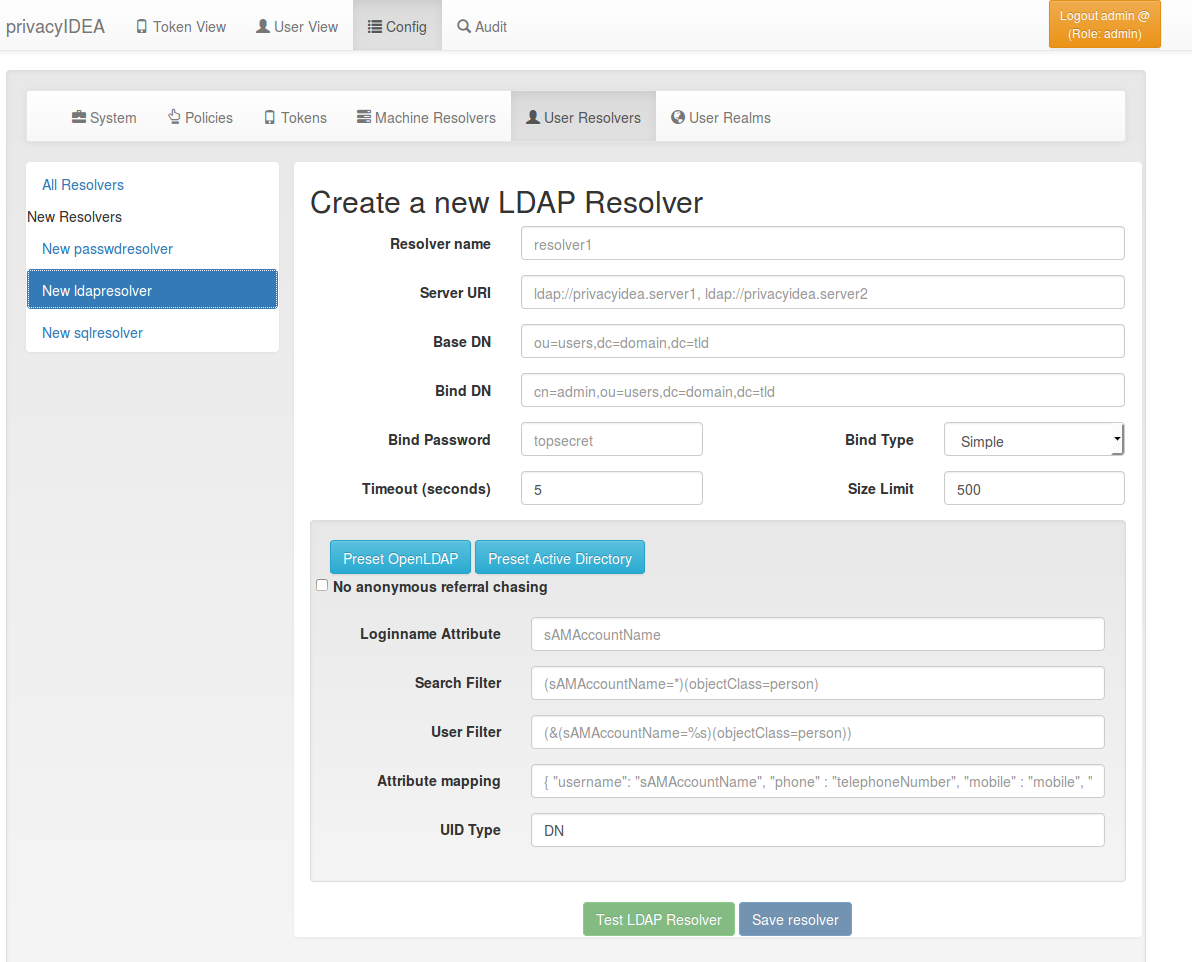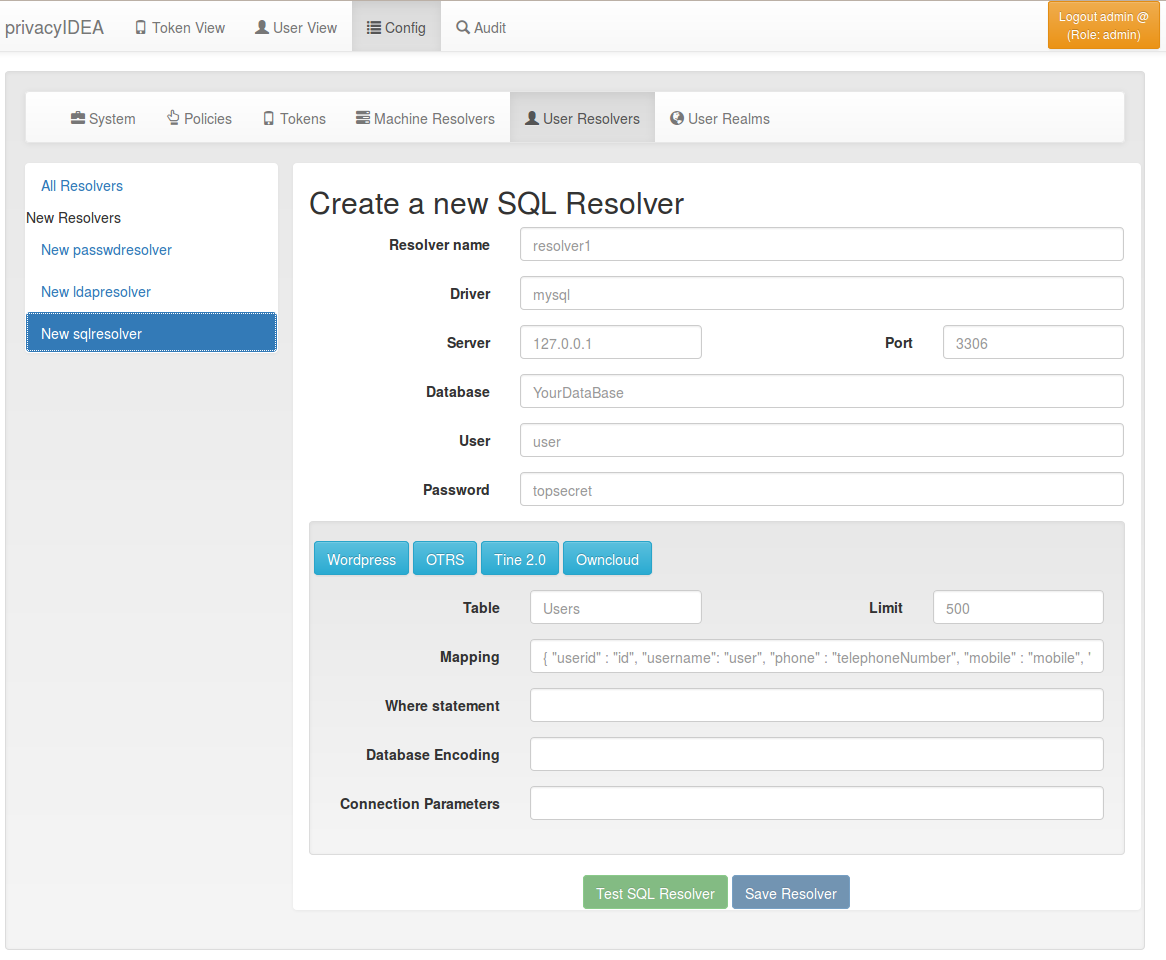4.1. UserIdResolvers¶
Each organisation or company usually has its users managed at a central location. This is why privacyIDEA does not provide its own user management but rather connects to existing user stores.
UserIdResolvers are connectors to those user stores, the locations, where the users are managed. Nowadays this can be LDAP directories or especially Active Directory, some times FreeIPA or the Redhat 389 service. But classically users are also located in files like /etc/passwd on standalone unix systems. Web services often use SQL databases as user store.
Today with many more online cloud services SCIM is also an uprising protocol to access userstores.
privacyIDEA already comes with UserIdResolvers to talk to all these user stores:
- Flatfile resolver,
- LDAP resolver,
- SQL resolver,
- SCIM resolver.
Note
New resolver types (python modules) can be added easily. See the module section for this (UserIdResolvers).
You can create as many UserIdResolvers as you wish and edit existing resolvers. When you have added all configuration data, most UIs of the UserIdResolvers have a button “Test resolver”, so that you can test your configuration before saving it.
Starting with privacyIDEA 2.4 resolvers can be editable, i.e. you can edit the users in the user store. Read more about this at Manage Users.
Note
Using the policy authentication:otppin=userstore users can
authenticate with the password
from their user store, being the LDAP password, SQL password or password
from flat file.
4.1.1. Flatfile resolver¶
Flatfile resolvers read files like /etc/passwd.
Note
The file /etc/passwd does not contain the unix password.
Thus, if you create a flatfile resolver from this file the functionality
with otppin=userstore is not available. You can create a flatfile with
passwords using the tool privacyidea-create-pwidresolver-user.
Create a flat file like this:
privacyidea-create-pwidresolver-user -u user2 -i 1002 >> /your/flat/file
4.1.2. LDAP resolver¶
The LDAP resolver can be used to access any kind of LDAP service like OpenLDAP, Active Directory, FreeIPA, Penrose, Novell eDirectory.
In case of Active Directory connections you might need to check the box
No anonymous referral chasing. The underlying LDAP library is only
able to do anonymous referral chasing. Active Directory will produce an
error in this case [1].
The Server URI can contain a comma separated list of servers.
The servers are used to create a server pool and are used with a round robin
strategy [3].
Example:
ldap://server1, ldaps://server2:1636, server3, ldaps://server4
This will create LDAP requests to
- server1 on port 389
- server2 on port 1636 using SSL
- server3 on port 389
- server4 on port 636 using SSL.
The Bind Type with Active Directory can either be chosen as “Simple” or
as “NTLM”.
Note
When using bind type “Simple” you need to specify the Bind DN like cn=administrator,cn=users,dc=domain,dc=name. When using bind type “NTLM” you need to specify Bind DN like DOMAINNAME\username.
The LoginName attribute is the attribute that holds the loginname. It
can be changed to your needs.
The searchfilter and the userfilter are used for forward and backward search the object in LDAP.
The searchfilter is used to list all possible users, that can be used
in this resolver.
The userfilter is used to find the LDAP object for a given loginname.
This is why the userfilter contains the python string replacement parameter
%s, which will be filled with the given loginname to find the
LDAP object.
The attribute mapping maps LDAP object attributes to user attributes in
privacyIDEA. privacyIDEA knows the following attributes:
- username,
- phone,
- mobile,
- email,
- surname,
- givenname.
The UID Type is the unique identifier for the LDAP object. If it is left
blank, the distinguished name will be used. In case of OpenLDAP this can be
entryUUID and in case of Active Directory objectGUID.
4.1.3. SQL resolver¶
The SQL resolver can be used to retrieve users from any kind of SQL database like MySQL, PostgreSQL, Oracle, DB2 or sqlite.
In the upper frame you need to configure the SQL connection.
The SQL resolver uses SQLAlchemy internally.
In the field Driver you need to set a driver name as defined by the
SQLAlchemy dialects
like “mysql” or “postgres”.
In the SQL attributes frame you can specify how the users are
identified.
The Database table contains the users.
Note
At the moment only one table is supported, i.e. if some of the user data like email address or telephone number is located in a second table, those data can not be retrieved.
The Limit is the SQL limit for a userlist request. This can be important
if you have several thousand user entries in the table.
The Attribute mapping defines which table column should be mapped to
which privayIDEA attribute. The known attributes are:
- userid,
- username,
- phone,
- mobile,
- email,
- givenname,
- surname.
You can add an additional Where statement if you do not want to use
all users from the table.
Note
The Additional connection parameters
refer to the SQLAlchemy connection but are not used at the moment.
4.1.4. SCIM resolver¶
SCIM is a “System for Cross-domain Identity Management”. SCIM is a REST-based protocol that can be used to ease identity management in the cloud.
The SCIM resolver is tested in basic functions with OSIAM [2], the “Open Source Idenitty & Access Management”.
To connect to a SCIM service you need to provide a URL to an authentication
server and a URL to the resource server. The authentication server is used to
authenticate the privacyIDEA server. The authentication is based on a client
name and the Secret for this client.
Userinformation is then retrieved from the resource server.
The available attributes for the Attribute mapping are:
- username,
- givenname,
- surname,
- phone,
- mobile,
- email.
Footnotes
| [1] | http://blogs.technet.com/b/ad/archive/2009/07/06/referral-chasing.aspx |
| [2] | http://www.osiam.org |
| [3] | https://github.com/cannatag/ldap3/blob/master/docs/manual/source/servers.rst#server-pool |


